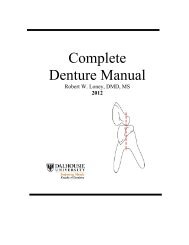RPD Manual 11 - Removable Prosthodontics - Dalhousie University
RPD Manual 11 - Removable Prosthodontics - Dalhousie University
RPD Manual 11 - Removable Prosthodontics - Dalhousie University
Create successful ePaper yourself
Turn your PDF publications into a flip-book with our unique Google optimized e-Paper software.
A. Definitions<br />
Introduction to <strong>Removable</strong> Partial Dentures<br />
Introduction to <strong>Removable</strong> Partial Dentures - 1<br />
1. Partial denture: A prosthesis that replaces one or more, but not all of the natural teeth<br />
and supporting structures. It is supported by the teeth and/or the mucosa. It may be fixed<br />
(i.e. a bridge) or removable.<br />
2. <strong>Removable</strong> partial denture (<strong>RPD</strong>): A partial denture that can be removed and replaced<br />
in the mouth by the patient.<br />
3. Interim denture (provisional; temporary): A denture used for a short interval of time to<br />
provide:<br />
a. esthetics, mastication, occlusal support and convenience.<br />
b. conditioning of the patient to accept the final prosthesis.<br />
4. Retention: Resistance to removal from the tissues or teeth<br />
5. Stability: Resistance to movement in a horizontal direction (anterior-posteriorly or<br />
medio-laterally<br />
6. Support: Resistance to movement towards the tissues or teeth<br />
7. Abutment: A tooth that supports a partial denture.<br />
8. Retainer: A component of a partial denture that provides both retention and support for<br />
the partial denture<br />
B. Treatment Objectives<br />
1. preserve remaining teeth and supporting structures<br />
2. restore esthetics and phonetics<br />
3. restore and/or improve mastication<br />
4. restore health, comfort and quality of life<br />
C. Alternatives to <strong>RPD</strong>'s (Treatment Options - Important for Informed Consent)<br />
1. No Treatment (Shortened Dental Arch)<br />
- Most patients can function with a shortened dental arch (SDA)<br />
- Requires anterior teeth + 4 occlusal units (symmetric loss) or 6 occlusal units<br />
(asymmetric loss) for acceptable function (opposing PM =1 unit, opposing molars<br />
= 2 units)<br />
- <strong>RPD</strong> doesn’t usually improve function if minimal occlusal units present<br />
2. Fixed partial denture – requires abutments at opposite ends of edentulous space, more<br />
expensive than <strong>RPD</strong>, must grind down abutments, flexes and can fail if too long.<br />
3. Implant supported prosthesis – most costly, closest replacement to natural dentition,<br />
less costly over long term<br />
4. Complete denture (if few teeth left, with poor prognosis); if replacement of missing<br />
teeth is very complex or costly<br />
D. Indications for <strong>RPD</strong>'s<br />
1. lengthy edentulous span (too long for a fixed prosthesis)<br />
2. no posterior abutment for a fixed prosthesis<br />
3. excessive alveolar bone loss (esthetic problem)















